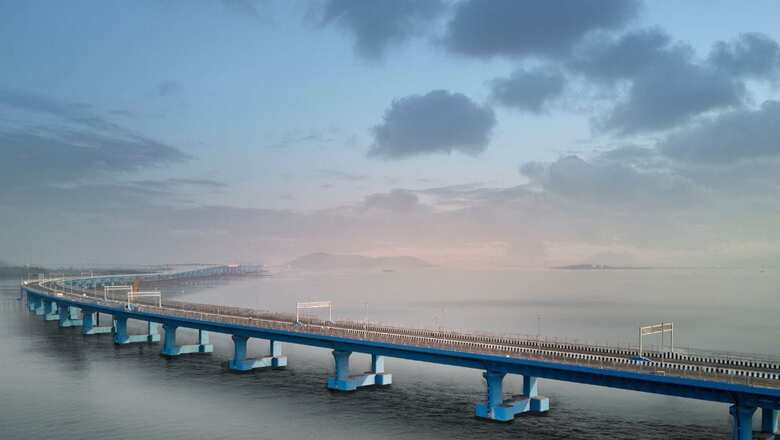
views
The Mumbai Trans Harbour Link (MTHL), which is set for inauguration on January 12, News18 spoke with the Mumbai Metropolitan Region Development Authority (MMRDA) commissioner Sanjay Mukherjee who called the India’s longest sea bridge an “engineering marvel” where new set of technologies have been used.
News18 had the opportunity to go on the deck of the bridge and experience it.
Mukherjee told News18, “This bridge is so unique that it has been built on land, mud flap and water. It is environmentally sustainable and has received appreciation from environmental groups. We have used modern and absolute state-of-the-art technology for the first time in the country with proper execution. Orthotropic steel deck, reverse circulation rigs, noise silencers, sound barriers, and an earthquake resistance system have been used to build the bridge”.
While constructing the 22 km-long bridge, safety and security measures were the main focus. Mukherjee believes that the bridge is important not only for Mumbai Metropolitan Region but also for Mumbai city, which is the financial capital of the country. “As we travel on this bridge we can see various view barriers. We had a thought during the initial stage that the structure of the bridge has to withstand any untoward incident. If a ship drifts off and hits the piles and pillars of the bridge, it will still stand as our pile caps have gone down 150ft below the rock surface to give that stability to this bridge. Thus, this bridge is two and half times more sustainable and resilient to earthquakes, which normally happens in a seismic zone”.
To keep constant watch on vehicles and help them during an emergency, intelligent traffic management system has been installed on the bridge. “As far as traffic is concerned, we have installed India’s most intelligent state-of-the-art traffic management system where we can get the (image) number plate of the vehicles on the bridge. We can also see the face of the driver clearly if the vehicle stops anywhere on the bridge. Our control room will get to know him/ her immediately. During an emergency, we have placed a calling point on the bridge, which can also be mapped immediately,” explained Mukherjee. The authority has also installed speed guns on the bridge to keep track of the vehicle movement.
The biggest challenge, according to Mukherjee, to construct the bridge was to maintain the vibration levels under control so that the marine life and flamingo movement does not get affected. The Sewri area along the eastern edge of South Mumbai, which is where one end of the bridge lies, sees migration of flamingos. “The most important technology, which we have used is reverse circulation rigs. These rigs cause minimum vibrations and impact on neighbouring areas…we also used noise silencers on machines, which helped us to maintain the noise levels to minimum so that the marine life and flamingos wouldn’t get disturbed. We have also installed debris management so that the waste does not fall into the sea and affect the marine life,” he added.
The MMRDA chief also believes that the bridge will “certainly” solve the traffic issue plaguing the Mumbai city by opening up an alternative route to reach Navi Mumbai.
From the economic growth perspective, the bridge will play a key role. “The bridge joins the ‘elder brother’, which is Mumbai city, to the hinterland, which is Navi Mumbai. Mumbai is a city that is starving of space and Navi Mumbai is a hinterland, which is looking for opportunities…Hinterland Mumbai can now get easy access to Mumbai and be part of their growth while Mumbai will get the opportunity to move to the hinterland and live there for the easy quality of life and hassle-free commute. On every trip, you can save Rs 700-Rs 800 on fuel. There are further connectivity plans. I feel India’s growth story has just started”.
On the debate on making the bridge “toll free”, Mukherjee said he is still awaiting the toll notification, but the fee collection mechanism is already in place.
Recently, Chief Minister of Maharashtra Eknath Shinde mentioned that the toll has been fixed at Rs 250 and it will be proportionate to that for other vehicles. “We have to understand clearly that the toll for other sea link is Rs 85-Rs 90. So, by that proportion, it comes to a much bigger amount which is Rs 500. But the government has decided the toll to be Rs 250. Whenever an economic decision takes place, there will be the concept of alternative cost, which is also known as opportunity cost. If we make this road toll-free, then you have to repay the loan taken to construct this bridge by using some other resources. So, in taxation, the fundamental thing is that the user pays. The person who uses the bridge will have to pay the toll. If you are saving Rs 700-Rs 800 on fuel, with the help of this bridge, toll amount has been kept at appropriate levels.”
MTHL, which will be officially called as ‘Atal Setu’, will be inaugurated by Prime Minister Narendra Modi on January 22. The bridge will give faster connectivity with the proposed Navi Mumbai International Airport, JNPT Port, Mumbai-Pune Expressway and Mumbai-Goa Highway. On the Mumbai side, connectivity with coastal road is also planned through the Sewri-Worli Elevated Connector project.


















Comments
0 comment